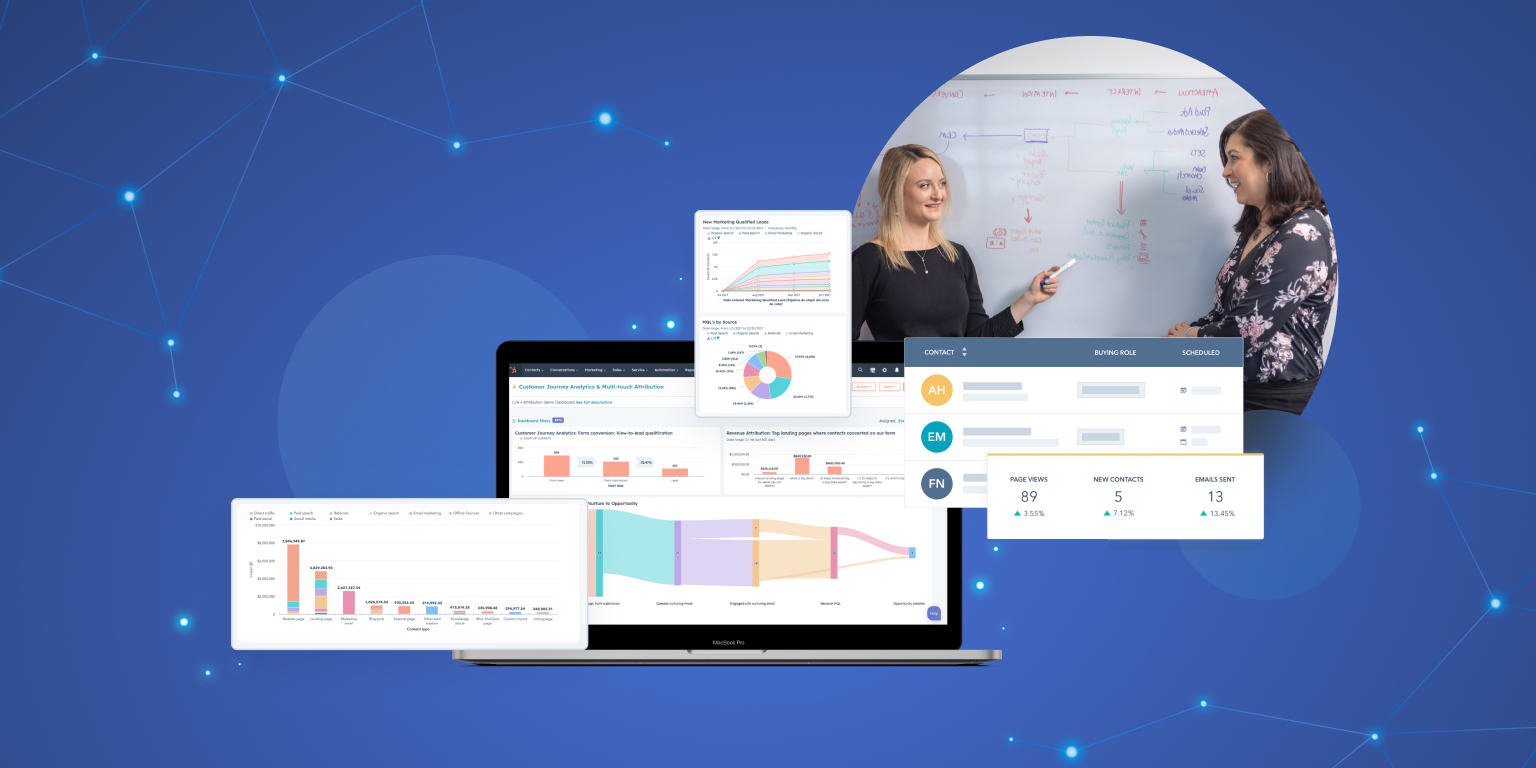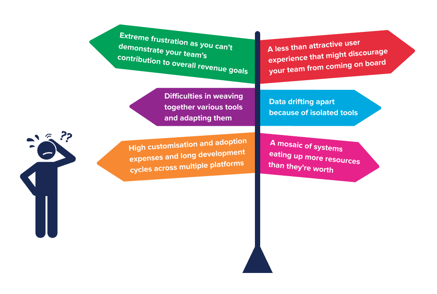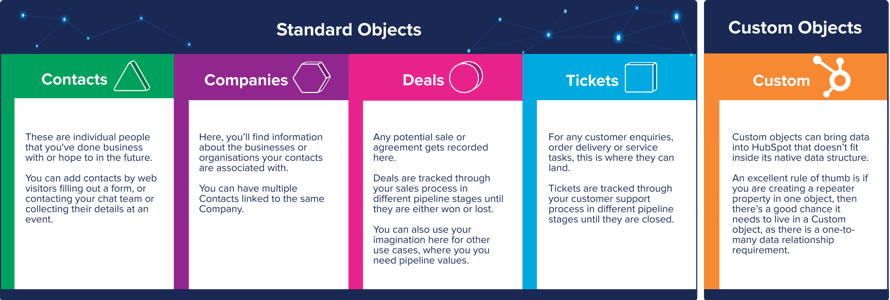
If you’re likely facing some (or all) of the following challenges, you are probably experiencing a crisis of disconnection.
 Extreme frustration as you can’t demonstrate your team’s contribution to overall revenue goals
Extreme frustration as you can’t demonstrate your team’s contribution to overall revenue goals- A less-than-attractive user experience that might discourage your team from coming on board
- Difficulties in weaving together various tools and adapting them
- Data drifting apart because of isolated tools
- High customisation and adoption expenses and long development cycles across multiple platforms
- A mosaic of systems eating up more resources than they’re worth
So, you’re standing at the intersection of technology and connectivity. Imagine a world where you have fulfilled your goal to find that one magical tool to perfect your customers’ journey insights, ensuring every step is visible and transparent.
As you’ve probably noticed, there’s no ‘magic wand’ CRM that fits everyone’s needs. Instead, you find yourself drowning in a sea of specialised tools, leading to towering tech stacks and redundant products.
The result? You might feel miles away from your customers, struggling to see how your marketing, sales, and customer service gears mesh together to drive your ultimate business goals.
The cherry on top? Communication gaps among your teams, potentially putting a dent in your customer experience.
The culprit? Fragmented systems. But don’t lose hope. Your HubSpot environment can be the compass you’ve been looking for.
Here’s a startling revelation from HubSpot: while the average company has 254 SaaS apps at its fingertips, they actively use only about 45% of them. Before diving in to configure your HubSpot portal, familiarise yourself with the groundwork needed for a thriving HubSpot data ecosystem, and join us as we delve into how to evaluate, visualise, and blueprint your HubSpot Environment to pave the way for your success.
How to solve the crisis disconnection on your HubSpot? Easy. Don’t lose hope because here we have for you the 5 simple and easy-to-implement best practices on HubSpot foundation configuration.
Define the HubSpot Objects That Best Fit Your Organisation, Goals and Processes
Think of objects as building blocks in your HubSpot universe. You’re probably already familiar with HubSpot’s main standard objects like Contacts, Companies, Deals and Tickets. HubSpot recently implemented a new Custom Objects feature, making it more flexible to adapt to your specific needs.
HubSpot Object Types:
- Contacts
- Companies
- Deals
- Ticket
- Custom

Define the Properties
Each object in HubSpot comes with properties – specific pieces of information about that object. For instance, for Contacts, properties could be their persona, lifecycle, email, phone number, or last purchase date. By tailoring these properties to match your unique business needs, you’re essentially customising HubSpot to think and act like you do.
HubSpot Property Types:
Text Input- Single-line text
- Multi-line text
- Phone Number
- Single Checkbox
- Multiple Checkbox
- Dropdown/radio select
- Date Picker
- Numbers
- Calculation
- Score
- File
- HubSpot user
- Rich text

Create Your List and Segment Your Contacts
You should personalise your communication so you can communicate differently with loyal customers, suppliers, and new leads.
HubSpot List Types:
- Static Lists
- Dynamic Lists
Data Integrations
You’ve probably got other tools you adore. And guess what? HubSpot plays well with others. Connect your favourite apps and tools, letting data flow seamlessly. With everything integrated, you’re not juggling between platforms but mastering them all from one central place. Use your HubSpot platform to centralise your team and all your systems and do away with overlapped and siloed systems.
HubSpot Integration Apps List
Utilise HubSpot data sync to establish either a one-way or two-way connection between HubSpot and your other applications, consolidating all your customer data within a single platform. Depending on the application, you can synchronise contacts, companies, deals, products, invoices, activities, and sales orders through data sync. Explore the list of apps that employ data sync capabilities with the HubSpot’s tool on your account here.
The Top 10 Most Popular HubSpot Apps:
- Salesforce
- Outlook platforms
- WordPress
- Zoom
- Zapier
- Google Ads
- Facebook Ads
- LinkedIn Sales Navigator and LinkedIn Ads
- Slack
- Mailchimp
Data Hygiene
Your HubSpot environment is like a garden. Occasionally, you’ll need to weed out outdated or inaccurate data. Regularly auditing and cleaning your database ensures that your decision-making is based on the freshest, most relevant insights. HubSpot has easy tools for doing this in the Data Quality area, but good housekeeping. practices will also ensure it will run like a well-oiled machine and you can rely on your data confidently.
HubSpot Data Cleansing Tools
- Remove duplicate contacts. Find and merge duplicated contacts. To avoid this issue in the future, keep your core tools synchronised. HubSpot uses emails as the validation token to identify unique contacts. If your contacts are using different emails, identify the secondary property that might give you the guide to separate or merge IDs.
- Correct structural errors. It refers to typos, inconsistent abbreviations, or unusual naming conventions. Regularly, this issue happens due to manual data entries or lack of standardisation. To correct this issue, it is recommended to standardise and use prefilled options.
- Address missing data. Blank spaces are inevitable, but you can rely on AI tools to complete data and minimise the negative impact on your data analysis.
- Keep your data fresh. As well as missing data, you can use AI tools to scan emails, websites and other industry information to keep your database up-to-date.
- Standardise data entry. Create rules, data restrictions and easy-to-understand properties. Also, determine a data sync mapping to facilitate your work.
Report and Dashboards
Once you’ve got your data in place, you’ll want to make sense of it all. HubSpot’s reporting tools let you visualise data trends, giving you clear insights into what’s working and where there’s room for improvement.
Remember, you’re not just collecting data; you’re weaving stories, spotting trends, making informed decisions and understanding your market universe or as the team at Fileroom calls it ‘Data-Verse’. With these HubSpot data fundamentals at your fingertips, you’re not just playing the digital game - you’re mastering it.
If you want to learn more about how to leverage your data to drive growth, download our Playbook with useful tools and recommendations to get the most out of your HubSpot to maximise sales outcomes and keep your team working on customer solutions rather than collating data across platforms.



.png)






